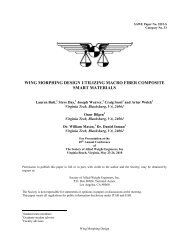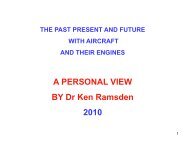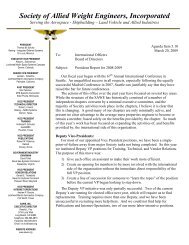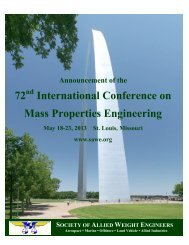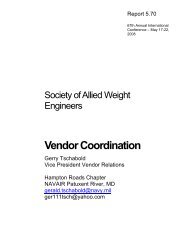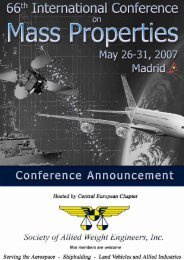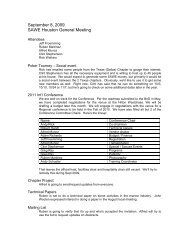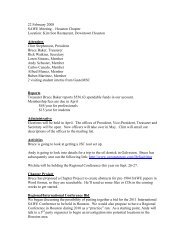Mass Properties - Society of Allied Weight Engineers
Mass Properties - Society of Allied Weight Engineers
Mass Properties - Society of Allied Weight Engineers
You also want an ePaper? Increase the reach of your titles
YUMPU automatically turns print PDFs into web optimized ePapers that Google loves.
Social Events<br />
Sunday – 6 May 2012 – Palace Nymphenburg & Oberschleißheim Aircraft Museum<br />
To celebrate the birth <strong>of</strong> their son and heir, Elector Ferdinand<br />
Maria and his consort, Henriette Adelaide, <strong>of</strong> Savoy charged<br />
architect Agostino Barelli with the building <strong>of</strong> a summer<br />
residence west <strong>of</strong> Munich. The simple cube-shaped building,<br />
begun in 1664, was enlarged under Max Emanuel and Karl<br />
Albrecht from plans by Henrico Zuccalli and Joseph Effner.<br />
The massive Great Hall (“Steinerner Saal”) was decorated<br />
in the Rococo style by Johann Baptist Zimmermann and<br />
François Cuvilliés the Elder under Elector Max III Joseph.<br />
A famous feature <strong>of</strong> the palace is the Gallery <strong>of</strong> Beauties,<br />
painted for King Ludwig I by Joseph Stieler. Beside the<br />
palace, the extended historic park invites one to walk and<br />
enjoy the beauty.<br />
After this visit, we will have a short bus ride to Schleißheim Palace. After lunch in the Palace restaurant, we will<br />
visit the Flugwerft.<br />
The Flugwerft Schleißheim branch is located some 18 kilometres north <strong>of</strong> Munich’s city centre, close to<br />
Schleißheim Palace. It is based on the premises <strong>of</strong> one <strong>of</strong> the first military airbases in Germany, founded just<br />
before World War I. It comprises the old air control and command centre building, as well as modern buildings<br />
added in the late 2000s after strong endorsement from Franz-Josef Strauss, the prime minister <strong>of</strong> the local state<br />
<strong>of</strong> Bavaria at the time. Franz-Josef was a passionate flyer.<br />
The “Flugwerft Schleißheim” displays various interesting airplanes for which not enough space was available<br />
at the “Museumsinsel” site in downtown Munich. Among the more prominent exhibits, there is a Horten flying<br />
wing glider built in the 1940s, restored from the few surviving parts. A collection <strong>of</strong> the German constructions<br />
<strong>of</strong> VTOL (vertical take <strong>of</strong>f and landing) planes developed in the 1950s and 1960s is quite unique. A range <strong>of</strong><br />
Vietnam era fighter planes as well as Russian planes taken over from East Germany after the reunification are<br />
shown. This outstation also features a workshop dedicated to the restoration <strong>of</strong> all kind <strong>of</strong> airplanes for the<br />
purpose <strong>of</strong> static display.<br />
Monday – 7 May 2012 – Daytime – Regensburg Tour<br />
Located on the Danube River, the Old Town <strong>of</strong> Regensburg<br />
with Stadtamh<strong>of</strong> is an exceptional example <strong>of</strong> a central-<br />
European medieval trading centre, which illustrates an<br />
interchange <strong>of</strong> cultural and architectural influences. A<br />
notable number <strong>of</strong> buildings <strong>of</strong> outstanding quality testify<br />
to its political, religious, and economic significance from the<br />
9th century. The historic fabric reflects some two millennia<br />
<strong>of</strong> structural continuity and includes ancient Roman,<br />
Romanesque, and Gothic buildings. Regensburg’s 11th-<br />
to 13th-century architecture still defines the character <strong>of</strong><br />
the town marked by tall buildings, dark and narrow lanes,<br />
and strong fortifications. The buildings include medieval<br />
patrician houses and towers, a large number <strong>of</strong> churches<br />
and monastic ensembles, as well as the 12th-century Stone<br />
Bridge. The town is also remarkable as a meeting place <strong>of</strong> general assemblies until the 19th century. Numerous<br />
buildings testify to its history as one <strong>of</strong> the centres <strong>of</strong> the Holy Roman Empire.<br />
©2012 SAWE – www.sawe.org 15<br />
Conference Announcement



